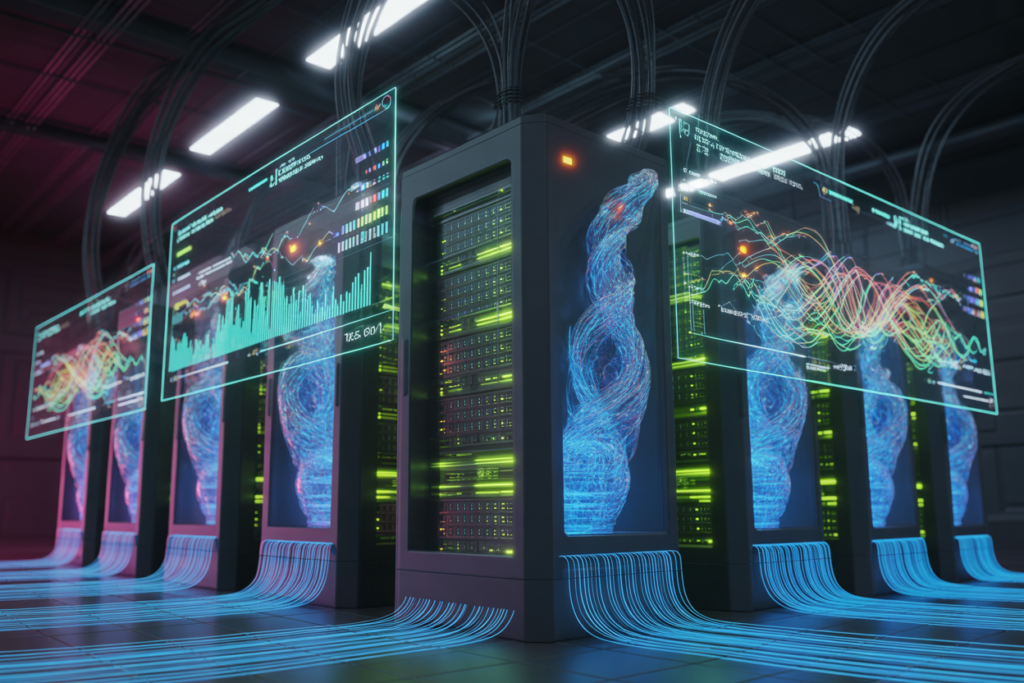Cloud Computing Services: Revolutionizing the Digital Landscape in 2025
Introduction
Cloud computing services have transformed the way businesses, governments, and individuals manage data, applications, and infrastructure, enabling unprecedented scalability, flexibility, and cost-efficiency. By delivering computing resources—such as servers, storage, databases, and software—over the internet, cloud services eliminate the need for on-premises hardware, democratizing access to advanced technology. As of October 2025, the global cloud computing market is valued at $680.1 billion, with projections to reach $1.44 trillion by 2029, growing at a compound annual growth rate (CAGR) of 20.6%, according to MarketsandMarkets. Dominated by giants like Amazon Web Services (AWS), Microsoft Azure, and Google Cloud Platform (GCP), the cloud ecosystem now integrates artificial intelligence (AI), edge computing, and quantum advancements to meet diverse needs—from startups to global enterprises. This article explores the fundamentals, types, advancements, applications, challenges, and future of cloud computing services, highlighting their role in shaping a connected, data-driven world.
The Fundamentals of Cloud Computing Services
What Is Cloud Computing?
Cloud computing refers to the on-demand delivery of computing resources—processing power, storage, networking, and software—via the internet, hosted on remote data centers managed by providers. Users access these services through subscription-based models, paying only for what they use, which contrasts with traditional capital-intensive IT infrastructure. Key characteristics include:
- Scalability: Resources scale dynamically to meet demand.
- Accessibility: Available globally via internet-connected devices.
- Cost-Efficiency: Pay-as-you-go models reduce upfront costs.
- Reliability: Redundant systems ensure 99.99% uptime.
Cloud services operate on three core models: Infrastructure as a Service (IaaS), Platform as a Service (PaaS), and Software as a Service (SaaS). Deployment options include public clouds (shared resources), private clouds (dedicated to one organization), and hybrid clouds (combining both). In 2025, hybrid clouds dominate, with 51% of enterprises adopting them for flexibility and security.
The Evolution of Cloud Computing
Cloud computing traces its roots to the 1960s with time-sharing systems, but it gained traction in the 2000s with AWS’s launch of EC2 in 2006, offering scalable virtual servers. The 2010s saw rapid adoption, with Microsoft Azure (2010) and GCP (2008) joining the fray, fueling a market boom. By 2025, advancements in AI, edge computing, and 5G have transformed clouds into intelligent platforms. Serverless computing, like AWS Lambda, now handles 4 trillion monthly invocations, while multi-cloud strategies mitigate vendor lock-in. Regulatory frameworks, such as the EU’s Data Act, ensure data sovereignty, shaping global adoption.
Types of Cloud Computing Services
1. Infrastructure as a Service (IaaS)
IaaS provides virtualized computing resources—servers, storage, and networking—on-demand. AWS EC2, Azure Virtual Machines, and GCP Compute Engine dominate, offering customizable instances for workloads. In 2025, IaaS accounts for 40% of cloud spending, with 70% of enterprises using it for scalable infrastructure. Bare-metal instances, like AWS’s EC2 Bare Metal, deliver near-native performance for high-performance computing (HPC).
Applications:
- Data Centers: Virtualized servers replace physical hardware.
- Big Data: Processing petabytes for analytics.
- Disaster Recovery: Backups ensure 99.999% data durability.
2. Platform as a Service (PaaS)
PaaS offers development environments, enabling developers to build and deploy applications without managing underlying infrastructure. Examples include AWS Elastic Beanstalk, Azure App Service, and Google App Engine. PaaS supports rapid development, with 65% of developers using it in 2025 for AI-driven apps.
Applications:
- App Development: Streamlined coding for startups.
- Microservices: Kubernetes-based orchestration for scalability.
- IoT: Managing millions of connected devices.
3. Software as a Service (SaaS)
SaaS delivers software over the internet, eliminating local installations. Salesforce, Microsoft 365, and Google Workspace lead, with SaaS comprising 50% of cloud revenue in 2025. AI-enhanced SaaS, like Adobe’s Creative Cloud, personalizes user experiences.
Applications:
- Productivity: Collaborative tools like Teams for remote work.
- CRM: Salesforce automates customer interactions.
- Education: Cloud-based learning platforms like Canvas.
4. Function as a Service (FaaS) and Serverless
FaaS, or serverless computing, allows developers to run code without managing servers. AWS Lambda, Azure Functions, and Google Cloud Functions execute code in response to events, scaling automatically. In 2025, serverless adoption has grown 30% year-over-year, handling microservices and IoT workloads.
Applications:
- Event-Driven Apps: Real-time data processing.
- Cost Savings: Pay-per-execution reduces costs by 60%.
- Scalability: Handles traffic spikes seamlessly.
Major Advancements in Cloud Computing Services
1. AI and Machine Learning Integration
AI is the backbone of 2025 cloud services, with providers embedding generative AI into platforms. AWS’s Bedrock, Azure’s OpenAI Service, and GCP’s Vertex AI enable custom model training, powering applications like predictive analytics and natural language processing (NLP). In 2025, 80% of cloud workloads involve AI, processing 10 zettabytes of data annually. On-device AI, supported by edge clouds, reduces latency to under 5ms.
Applications:
- Personalization: Netflix uses AI for tailored recommendations.
- Automation: Chatbots handle 70% of customer queries.
- Healthcare: AI analyzes medical imaging in milliseconds.

2. Edge Computing and 5G Synergy
Edge computing brings processing closer to data sources, reducing latency. AWS Wavelength, Azure Edge Zones, and GCP’s Anthos integrate with 5G, enabling sub-10ms response times for IoT and autonomous vehicles. In 2025, edge clouds handle 30% of enterprise data, up from 10% in 2022.
Impact:
- Real-Time Processing: AR/VR apps run smoothly.
- IoT Scalability: Manages 75 billion connected devices.
- Energy Efficiency: Edge reduces data transfer by 40%.
Case Study: Verizon’s 5G Edge with AWS Wavelength powers real-time analytics for smart cities, cutting traffic congestion by 15%.
3. Quantum and Hybrid Computing
Quantum computing is emerging, with AWS Braket and Azure Quantum offering hybrid quantum-classical solutions for cryptography and drug discovery. In 2025, quantum workloads are 5% of cloud tasks but grow at 50% CAGR. Hybrid clouds integrate on-premises quantum systems with public clouds for scalability.
Applications:
- Optimization: Solving logistics problems in seconds.
- Security: Quantum-resistant encryption.
- Research: Simulating complex molecules.
4. Serverless and Microservices
Serverless architectures, like AWS Lambda, scale instantly, handling 4 trillion monthly invocations in 2025. Kubernetes-based microservices, supported by Azure AKS, enable modular app development, reducing downtime by 50%.
Impact:
- Cost Efficiency: Pay-per-use cuts costs by 60%.
- Agility: Rapid deployment for startups.
- Resilience: Fault-tolerant microservices ensure uptime.
5. Sustainability and Green Computing
Cloud providers prioritize sustainability, with AWS and Google targeting net-zero carbon by 2030. Energy-efficient data centers use renewable sources, reducing emissions by 30%. AI optimizes cooling, saving 20% power.
Applications:
- Green Data Centers: Solar-powered facilities.
- Carbon Tracking: Tools monitor emissions in real-time.
- Circular IT: Recycled hardware reduces e-waste.

6. Security and Privacy Enhancements
Zero-trust architectures and AI-driven threat detection protect cloud data. AWS’s Nitro Enclaves and Azure’s Confidential Computing ensure data encryption at rest and in transit. Blockchain-based identity management, adopted by 20% of enterprises, secures access.
Impact:
- Compliance: Meets GDPR and CCPA standards.
- Threat Detection: AI blocks 99.9% of cyberattacks.
- Data Sovereignty: Localized storage ensures regulatory adherence.
Applications of Cloud Computing Services
1. Business and Enterprise Solutions
Cloud services power digital transformation, with 85% of enterprises adopting multi-cloud strategies in 2025. AWS’s ERP solutions streamline supply chains, while Azure’s Power BI drives data analytics.
2. Healthcare
Cloud platforms manage electronic health records (EHRs), with AWS HealthLake processing 100 petabytes of patient data. AI diagnostics reduce error rates by 30%.

3. Gaming and Entertainment
Cloud gaming platforms like Xbox Cloud Gaming and GeForce Now stream AAA titles, with 5G reducing latency to 10ms. Netflix uses AWS for 4K streaming to 300 million users.
4. Education and Research
Cloud-based platforms like Google Classroom support remote learning, while AWS’s HPC clusters accelerate scientific simulations.
5. IoT and Smart Cities
Clouds manage IoT data from 75 billion devices, with Azure IoT Hub optimizing traffic systems, cutting congestion by 15%.
Challenges in Cloud Computing Services
1. Security and Data Privacy
Cyberattacks rose 50% in 2024, targeting cloud vulnerabilities. GDPR fines for breaches exceed €1 billion annually.
2. Vendor Lock-In
Proprietary tools limit portability; multi-cloud strategies mitigate but increase complexity.
3. Cost Management
Unpredictable costs challenge SMEs, with 60% overspending due to poor optimization.
4. Latency and Reliability
Edge computing reduces latency, but 5G coverage gaps persist in rural areas.
5. Environmental Impact
Data centers consume 2% of global energy; renewables lag in emerging markets.
The Future of Cloud Computing Services
1. Quantum Computing Integration
By 2030, quantum clouds will dominate HPC, solving complex problems 100x faster.
2. 6G and Edge Evolution
6G will enable sub-1ms latency, powering holographic apps and autonomous systems.
3. Green and Decentralized Clouds
Decentralized clouds using blockchain will enhance privacy, while green data centers cut emissions by 50%.
Prediction: Cloud services will contribute $2 trillion to global GDP by 2030, driven by AI and IoT.
Societal Implications
Cloud computing democratizes technology, enabling startups and remote education, but risks data monopolies and digital divides. It cuts emissions via optimized workflows but demands sustainable practices. Ethical AI and transparent regulations ensure inclusivity and trust.
Conclusion
Cloud computing services in 2025 are the backbone of digital transformation, from AI-powered analytics to sustainable data centers. AWS, Azure, and GCP lead with innovative IaaS, PaaS, and SaaS solutions, powering industries from healthcare to gaming. Challenges like security and costs persist, but the future—blending quantum, 6G, and green tech—promises a connected, efficient world. As clouds evolve, they’ll empower society, provided we balance innovation with responsibility.
Leave a Reply